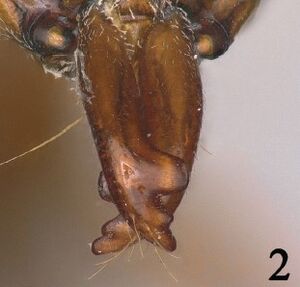Odontomachus linearis
| Odontomachus linearis | |
|---|---|

| |
| Scientific classification | |
| Kingdom: | Animalia |
| Phylum: | Arthropoda |
| Class: | Insecta |
| Order: | Hymenoptera |
| Family: | Formicidae |
| Subfamily: | Ponerinae |
| Tribe: | Ponerini |
| Genus: | Odontomachus |
| Species: | O. linearis |
| Binomial name | |
| Odontomachus linearis Chen & Zhou, 2018 | |
Nothing is known about the biology of Odontomachus linearis.
Identification
Chen and Zhou (2018) - Similar to Odontomachus fulgidus, but can be easily distinguished from the later by its longitudinal ridges of the dorsal propodeum, strongly contrasts to the transverse ridges of O. fulgidus. In addition, the three apical tooth of mandible distinctly shorter and blunter than the later one.
Keys including this Species
Distribution
Distribution based on Regional Taxon Lists
Palaearctic Region: China (type locality).
Distribution based on AntMaps
Distribution based on AntWeb specimens
Check data from AntWeb
Countries Occupied
| Number of countries occupied by this species based on AntWiki Regional Taxon Lists. In general, fewer countries occupied indicates a narrower range, while more countries indicates a more widespread species. |

|
Estimated Abundance
| Relative abundance based on number of AntMaps records per species (this species within the purple bar). Fewer records (to the left) indicates a less abundant/encountered species while more records (to the right) indicates more abundant/encountered species. |

|
Biology
Castes
Worker

| |
| . | |
Nomenclature
The following information is derived from Barry Bolton's Online Catalogue of the Ants of the World.
- linearis. Odontomachus linearis Chen & Zhou, in Chen, Shi & Zhou, 2018: 3, figs. 1-4 (w.) CHINA (Hunan).
- Type-material: holotype worker.
- Type-locality: China: Hunan, Ningyuan, Jiuningshan, 27.ix.2004, no. G041027 (J. Huang).
- Type-depository: GNUC.
- Distribution: China.
Unless otherwise noted the text for the remainder of this section is reported from the publication that includes the original description.
Description
Worker
Holotype. TL 8.10, HL 2.19, HW 1.59, CI 73, SL 1.79, SI 112, ML 1.13, ED 0.20, PW 0.91, MSL 2.46, PL 0.25, PH 0.89, DPW 0.36, LPI 356, DPI 142.
In full-face view head uniquely shaped, longer than broad (CI 73); posterior margin slightly concave, occipital carina V-shaped; median furrow as dark line on vertex; poster corner round, lateral margin distinctly concave, as wide groove extend to the middle of the poster part of the head. Mandible elongate and linear, masticatory margin consisting three large and truncate teeth, inner margin with four small and un-conspicuous denticles. Clypeus divided into three lobes, anterior margin of each lobe convex; frontal carinae short, not exceed the frontal lobe. Scape long, almost reaching posterior corner of head. Eye in middle size, situated at the anterior third of lateral margins of head.
In lateral view pronotum weakly convex; promesonotal suture markedly impressed; dorsum of mesonotum straight, slow down backwardly; Propodeum elongated, dorsum almost straight and gradually sloping posteriad, propodeal declivity weakly convex, posterodorsal corner blunt. Petiole widest at base, node distinctly and immediately narrowed dorsally, tapering apically to a short spine directed slightly rearward. subpetiolar process rounded triangular, ventral apex blunt. Sting extruding.
In dorsal view mesosoma slender; pronotum broadest, edges rounded; promesonotal suture obvious and metanotal groove absent.
Mandibles smooth and shining; in full face view frontal lobe with striae, diverging toward outside, the rest of head smooth and shining; in dorsal view the anterior neck of pronotum with weakly striaed, the rest part smooth and shining; mesonotum and propodeum with longitudinal and coarse ridges; posteroventral part of mesopleuron weakly striated; metapleuron weak striae. Petiole and gaster smooth and shiny. Apical tooth and ventral face of Mandibles with long setaes; poster part of gaster with a few short setaes; whole body with sparse pubescence. Head, mesosoma, petiole, and gaster reddish brown, legs yellowish brown.
Type Material
- Holotype, worker, Hunan, Ningyuan, Jiuningshan, China, 27 September 2004, Jianhua Huang, G041027, Insect Collection, Guangxi Normal University.
Etymology
The species is named after its dorsum of propodeum with longitudinal ridges.
References
References based on Global Ant Biodiversity Informatics
- Chen Z. L., F. M. Shi, and S. Y. Zhou. 2018. A new species of Odontomachus Latreille, 1804 (Hymenoptera: Formicidae) from China. Far Eastern Entomologist 356: 1-8.

